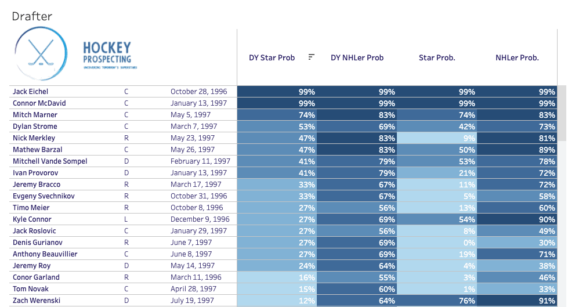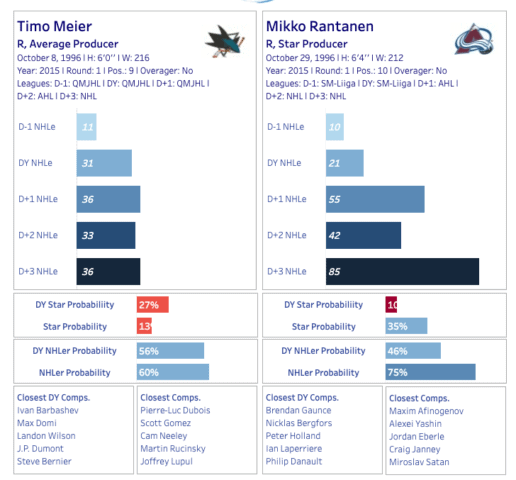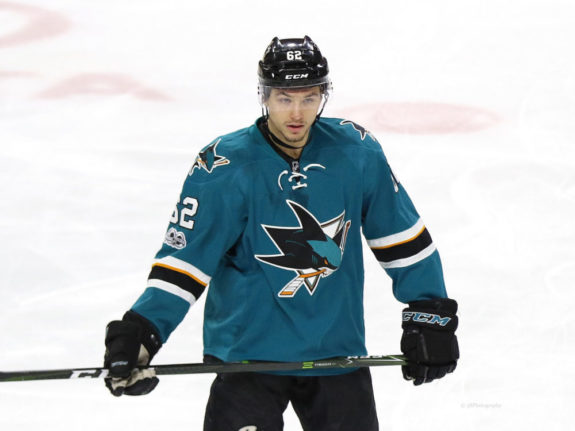Timo Meier was not a consensus top 10 pick by any means in 2015, but the San Jose Sharks took him at ninth-overall anyway. Although Meier still has the promise of developing into a legit NHL star, the Sharks passed on notable other first-rounders, like Mikko Rantanen, Mathew Barzal, Kyle Connor, Thomas Chabot, and Brock Boeser.
Related: Revisiting the Brent Burns Trade
Meier has had some success in the NHL sure, but how high is his ceiling? Was the 66 points in 78 games in 2018-19 his ceiling? Or is there another gear he has yet to hit?
Draft Year Comparables
Let’s break down that 2015 draft with the help of Hockey Prospecting. In his draft year, he was around the fourth-tier of talent with Connor and Beauvillier in terms of likelihood of being a star. Some of the players ahead of him have yet to break out into stars, after all, these are just percentages so they may never.

Since his draft year, you can see Meier’s star probability has taken a hit from 27 percent all the way down to 13 percent. Not terrible, but he hasn’t risen like Connor, Werenski, Barzal or Sompel. Certainly others in his tier have fallen even further so all is not lost.
Who Are Meier’s Comparables?
When trying to decide what trajectory a player’s career may take, it is helpful to look at comparables. To do this, Evolving Hockey looks at a players’ complete statistics for a season or range of seasons. According to evolving hockey the five players most similar to Meier during the same age range of their career, in order of most similar, are:
- Jonathan Huberdeau
- Evander Kane
- Brendan Gallagher
- David Pastrnak
- Taylor Hall
Aside from Gallagher, a very good player in his own right, the other four on this list are current NHL stars. One thing that Huberdeau and Pastrnak have that the other three do not is an elite centerman to set them up for a lot of goals. Hall and Kane have had great success with a variety of centers. A close look at the number comparison shines a light on what to expect for Meier:
| Player | G/60 | A1/60 | A2/60 | Points/60 | iSF/60 | ixG/60 | iBLK/60 | iHF/60 | Seasons |
| Meier | 1.17 | .64 | .61 | 2.42 | 10.58 | 1.21 | 2.02 | 5.76 | 17-20 |
| Huberdeau | .97 | .96 | .7 | 2.63 | 7.95 | .96 | 1.45 | 1.91 | 15-18 |
| Kane | 1.11 | .77 | .35 | 2.23 | 11.93 | 1.17 | 1.42 | 7.94 | 10-13 |
| Pastrnak | 1.31 | .8 | .62 | 2.73 | 10.28 | .99 | 1.29 | 3.2 | 14-17 |
| Hall | 1.24 | .94 | .59 | 2.78 | 10.48 | 1.18 | 1.74 | 2.22 | 10-13 |
This table has a lot of valuable insights. First to note is that these players did have remarkably similar numbers in certain areas to Meier when they were his age. Second, Meier leads the pack in individual expected goals per 60 minutes (ixG/60), which frankly astounded me. Third, Meier is a volume shooter, like everyone else on this list except for Huberdeau. Fourth, peripheral coverage is pretty great for Meier, second only to maybe Kane, though his blocks are the highest. Fifth, he doesn’t have a particularly high rate of secondary assists, which tend to vary much more than primary assists. All-in-all, I would say this chart contains pretty apt comparables.
How Does Meier Compare to Rantanen?
I remember watching this draft and being very excited that the Sharks were going to select Mikko Rantanen. That obviously didn’t happen and I have watched these two closely over the past few seasons as obvious comparables due to their draft position. In his draft year, Rantanen had an even lower star probability than Meier, but that has risen significantly in the last few years.

It doesn’t hurt to have superstar center Nathan MacKinnon dishing him the puck either. Looking into the numbers at HockeyViz, MacKinnon definitely helps Rantanen, but Rantanen helps all other players be more dangerous and helps MacKinnon (not that he needs it) be even more dangerous. I think it is safe to say Rantanen is not “just” riding the coattails of MacKinnon. It would be amazing to see Meier play with a center as talented as MacKinnon just to adequately compare the two 2015 top-10 draft picks.
Where Do Meier’s Rates Rank Him Now?
Since his first full season in the league, 2017-18, Meier is 19th in the league in ixG/60, just ahead of teammate Tomas Hertl. Above Meier in the top 20 are superstars like Ovechkin, Matthews, Seguin, Kane, Pacioretty and burgeoning stars like Brady Tkachuk and Andrei Svechnikov. When looking at counting statistics, Meier is 59th in the league in actual goals during that time frame, which is a huge discrepancy. As you might imagine, he has about 1000 fewer minutes played than the top scorers like Ovechkin, Draisaitl, McDavid, and MacKinnon. With an increase in minutes, the points should follow.
A Matter of Time?
Meier saw an uptick in point pace from 36 in 2017-18 to 69 in 2018-19. This uptick coincided with just over a two-minute increase in average time on ice. In 2019-20, his average time on ice only increased 19 seconds from the previous season. If Meier is going to reach the heights of Huberdeau, Pastrnak, and Hall, he will need to see similar ice time. For the record, those players averaged 18.46, 18:58, and 19:10 this season. There aren’t too many reasons not to give Meier that amount of ice time, though his defensive acumen might be one.
In Defense of Limiting Ice Time
Meier sits next to Kevin Labanc in expected goals per 60 minutes (a plot of expected goals against versus expected goals for per 60 minutes) where they are both defensive liabilities. Meier has improved his defensive game over time, decreasing the opposing team threat level while he is on the ice, but that took a tumble this year. It is hard to say how much of that was due to the team effect, but he was not Hertl. Hertl is the only one in the “good” category of xG rates on the Sharks or the 2019-20 season.

Meier didn’t play with Hertl very often in 2019-20 (only 17 percent of the time). Playing with Hertl would probably solve a lot of the problems for Meier in that he would get the best offensive center on the team and have someone to help with his defensive liabilities.
What About His Linemates?
Part of the issue I believe is that Meier hasn’t had a regular center since entering the league. Since entering the league, he has only had a consistent linemate for at most 25 percent of his shifts in 2018-19 when he was flanked by Logan Couture and Joe Pavelski. Compared to Pastrnak who has been essentially attached to Patrice Bergeron’s hips for at least 45 percent of his shifts since 2016-17, the year he emerged as a dynamic scorer. There is no doubt it can take time to develop chemistry with a linemate and Meier just hasn’t had that luxury.
Where is the Power Play Time?
An obvious area Meier needs to improve upon if he is to join the ranks of the elite is power-play points (PPPs). Meier’s career-high was 10 PPPs in 2018-19, that he mostly got on the second power-play unit. He has never received consistent top power-play time. When Pavelski left in the offseason before the 2019-20 campaign, it was between Kane and Meier to get that fifth spot on the top unit. Kane won the job and put up a career-high 18 PPPs in only 64 games. His previous high was 11 the previous year in 75 games. It’s unclear if Meier gets top power-play time in 2020-21, it probably depends a lot on if Labanc is back, who is a bit of a power-play specialist.

The Sharks could certainly use Labanc’s services, but after he signed his one year “prove it” deal and failed to prove much of anything, him returning is a big question mark. If Meier is going to reach the heights of Pastrnak’s 38 PPPs or even Huberdeau’s 29, he will first need to be a regular on the top unit and secondly the Sharks will need to improve on their 23rd ranked power play. Both of those things are possible and if they do happen, Meier will be well on his way to drastically improving his point totals.

In a reassuring sign, Meier’s power-play time did rise this season, partly due to injuries of Hertl and at the very end Couture. However, the rising trend preceded the injuries so it seems likely his role on the man advantage will continue to grow.
Will Meier Reach Superstar Status?
Of course we don’t know the answer to that, but many signs point to yes. While player development is rarely linear, if Meier continues this trajectory, he will get there.
Related: Sharks’ Best Players in Franchise History
When he made the Sharks team out of camp ahead of the 2016-17 season, an illness delayed his NHL debut until Dec. 16. Those are not insignificant delays in the development of a young player. Now healthy, the biggest limiting factors appear to be ice time, power-play time, and the team around him. He should be getting more ice time as one of the best forwards on the team and the power-play time is a slight question as discussed with respect to Labanc.
The team around him is probably the most unsettled question as the Sharks hope to bounce back in 2020-21. The last time they failed to make the playoffs with an aging core, back in 2014-15, they went to the Cup Final the following season. They are hoping for a similar bounce-back, with an even older core minus Pavelski and Marleau, as well as some younger talent. If anyone is going to become the Sharks’ next star, I’m betting it is Timo Meier.